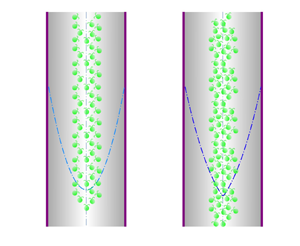Article contents
Dispersion of a gyrotactic micro-organism suspension in a vertical pipe: the buoyancy–flow coupling effect
Published online by Cambridge University Press: 05 May 2023
Abstract

Understanding the transport of micro-organisms in pipes is crucial to many fundamental problems, such as bioconvection and biodiesel production. In this work, we investigate the velocity profile and dispersion of a suspension of negatively buoyant, gyrotactic micro-organisms in a vertical pipe. With an imposed flow rate, the non-uniform radial cell concentration typical of gyrotaxis distorts the simple Poiseuille flow through inhomogeneous buoyancy, which in turn affects the cell concentration distribution. By solving the fundamental Smoluchowski equation and the Navier–Stokes equation simultaneously, we account for this bidirectional buoyancy–flow coupling effect. Asymptotic dispersion coefficients, namely, drift velocity and dispersivity, are further calculated with the obtained radial velocity and cell concentration profiles, which are assumed to be steady, symmetric and axially invariant. Using the gyrotactic micro-organism Chlamydomonas augustae as an example, detailed results are given to illustrate the effect of buoyancy–flow coupling. In downwelling flows, the buoyancy–flow coupling effect intensifies with the Richardson number  $Ri$ quantifying the mean cell concentration, but is strongest at a moderate flow strength. The buoyancy–flow coupling effect significantly enhances the velocity and cell concentration in the central region, as well as the drift velocity and dispersivity. In contrast, the buoyancy–flow coupling effect is comparatively limited in upwelling flows, due to the dominant influence of the no-slip boundary condition imposed at the wall. Comparisons with predictions of existing approximate models are also presented.
$Ri$ quantifying the mean cell concentration, but is strongest at a moderate flow strength. The buoyancy–flow coupling effect significantly enhances the velocity and cell concentration in the central region, as well as the drift velocity and dispersivity. In contrast, the buoyancy–flow coupling effect is comparatively limited in upwelling flows, due to the dominant influence of the no-slip boundary condition imposed at the wall. Comparisons with predictions of existing approximate models are also presented.
JFM classification
- Type
- JFM Papers
- Information
- Copyright
- © The Author(s), 2023. Published by Cambridge University Press
References
- 2
- Cited by





